The Grannom fly, also known as the Brachycentrus subnubilus, is the earliest sedge species to emerge on rivers across the United Kingdom. Its distinct characteristics make it easily recognizable as the sole sedge that can be found in the water during April. Its emergence marks the beginning of the spring season and serves as an important food source for trout.
This caddis fly changes colour as it flies away from the water. It emerges, with a vibrant green body with black bands and mottled grey-brown folded-back wings (size 10-12mm).
However, after a few minutes, its body will be tan-brown.
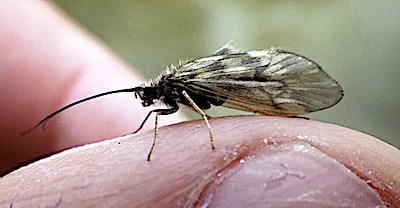
This sedge is found in most parts of the UK but hatches tend to be more significant in Northern England, Wales, and parts of Scotland.
Unlike many other flies, the Grannom fly hatch occurs for roughly two weeks, at best. Then you have to wait for another year.
Trout seem to sense this brief opportunity because, during a hatch, they often…
ignore any other fly.
So, which caddis fly patterns do I use on the Welsh Dee and northern UK rivers?
First up, is the…
Elk hair Grannom fly tying instructions:
I like this dry fly pattern formed from deer hair because it will…
float all day, and trout just snap it up.
Tying material list:
- Hook: #16 & 14 Kamasan B402
- Thread: Grey 8/0 Uni-Thread
- Tag: Fluorescent green floss
- Body: Elk deer hair (spun)
- Hackle: Brown Cock feather
Step-by-step tying guide:
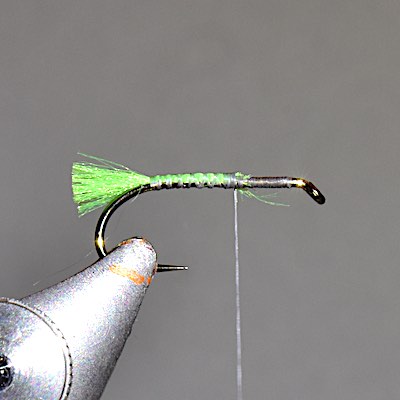
Step 1. Catch the waxed grey trying thread onto the hook 2 mm behind the eye. Tie in the fluorescent green floss tag.
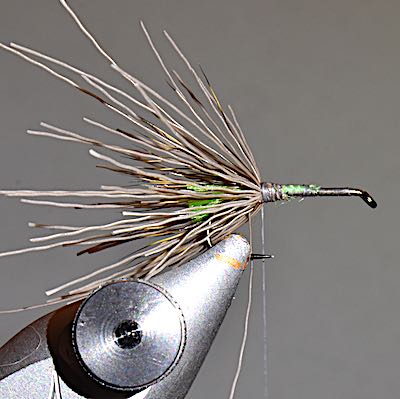
Step 2. Take a small bunch of deer hair, remove the guard hairs, and stack. Position the tips of the hair to protrude just past the tag and tie in. Pull back the butt ends and secure them with the thread.
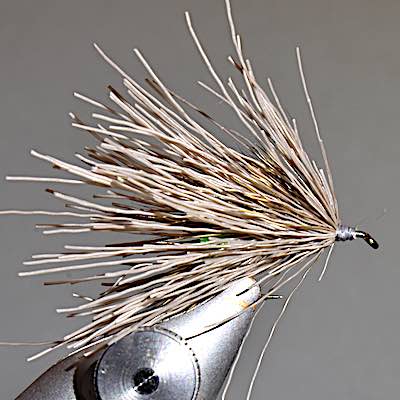
Step 3. Tie another small bunch of deer hair in front of the previous one and repeat this process until there is a 3mm gap to the hook eye.
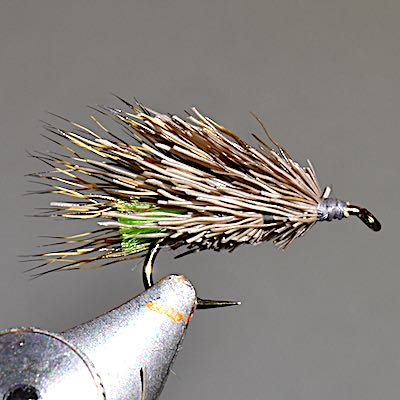
Step 4. Carefully trim the butt ends of the deer hair to form the shape of the Grannom fly wing.
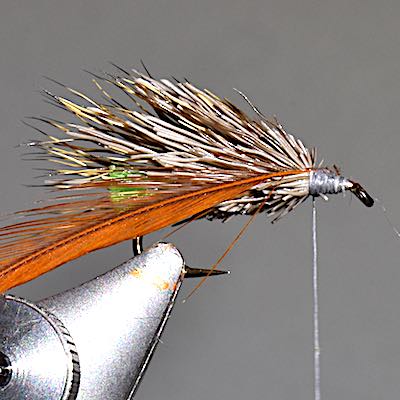
Step 5. Prepare the brown cock hackle feather and tie on to the hook.
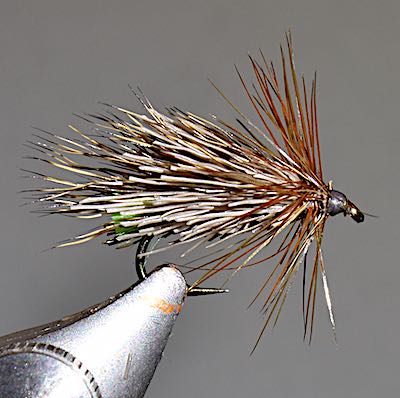
Step 6. Using hackle pliers, make 3 to 4 full turns and tie off the hackle. Finally, build a small head with the thread, whip finish, and apply varnish.
Sometimes a fly floating high on the water is refused because trout are fixated on taking the caddis fly as it emerges. This is when I tie on the following emerger pattern (designed by Davie McPhail) to catch the trout feeding on emergers.
Tying a Grannom fly emerger pattern
Tying material list:
- Hook: #14 Drennan Sedge hook
- Thread: Dark Brown 8/0 Uni-Thread
- Para Post: Grey Antron yarn
- Body: 50/50 mix of grey & green Partridge SLF dubbing
- Rib: Clear Mylar coloured on the inside with a green Sharpie
- Rear Wing: Coq de Leon fibres
- Thorax: Brown dubbing
- Hackle: Cree cock feather
Step-by-step tying guide:

Step 1. Secure the brown thread and wind down in touching turns and return to the middle between the eye and the point.
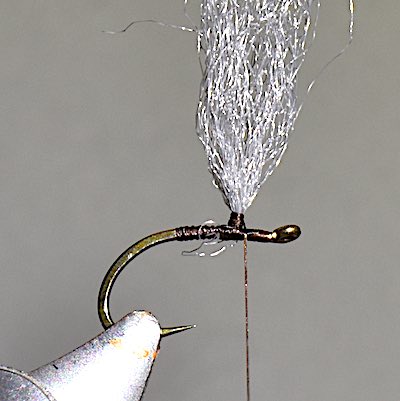
Step 2. Tie in a 2″ piece of grey Anton yarn to form a Para-post.
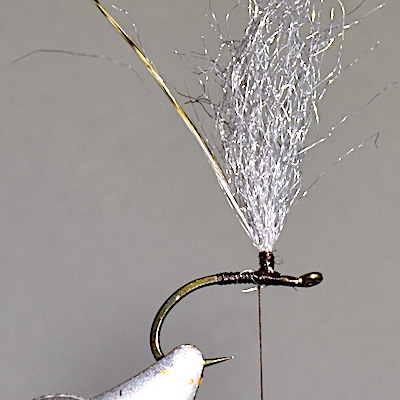
Step 3. Prepare a Cree cock hackle feather and tie it onto the hook and take the thread up the Para-post 2mm.
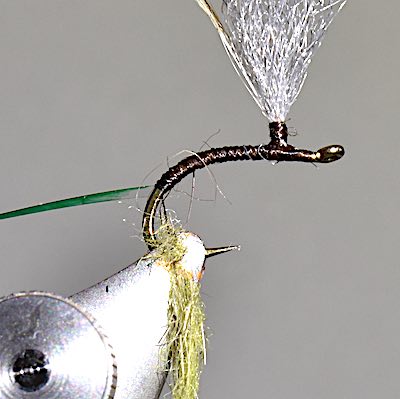
Step 4. Wind the thread down to the hook bend and tie in the clear Mylar rib. With a green Sharpie pen, colour the inside of the clear rib. Next, dub the thread with a 50/50 mix of grey and green SLF dubbing.
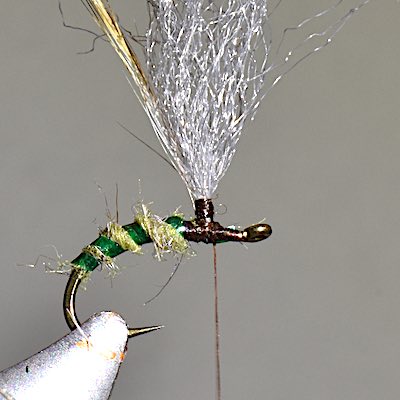
Step 5. Build the body of the fly by winding the dubbed thread up to the Para-post. Wind the green-coloured rib in 4 open tuns to the post and tie it off.
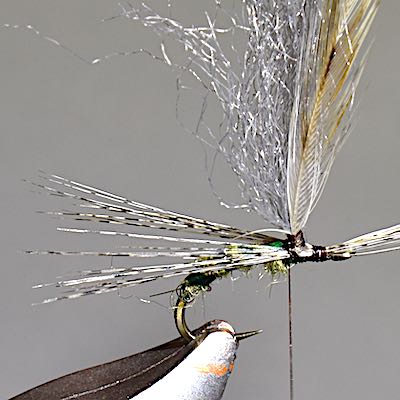
Step 6. Spit a bunch of Coq de Leon fibres in two and tie them in to form a V on either side of the Para-post.
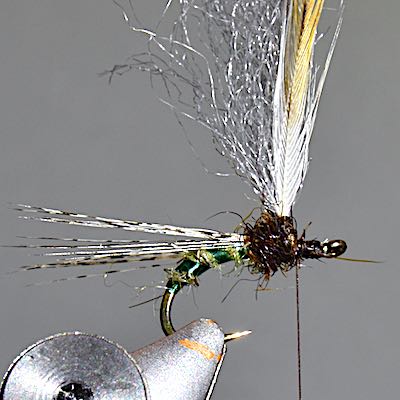
Step 7. Twist the brown dubbing on the thread and form a thorax behind the Para-post.

Step 8. Using hackle pliers, make 3 to 4 full turns or the Cree feather down the Para-post and tie off the hackle. Add more brown dubbing to the thread, and while holding the hackle back, form the front of the thorax and head of the fly.
The following video by Davie McPhail on how to tie this caddis fly is well worth watching.
Grannom fly fishing tips
On the Welsh Dee and rocky spate rivers, hatches are found in the stony runs and glides, and those are the places to focus your fishing efforts.
Examples of pools on the Welsh Dee include:
Whereas, on chalk streams, hatches tend to be concentrated around weed beds.
Throughout the day, you can observe numerous caddis flies in the atmosphere, but the primary hatch typically takes place from mid-morning for approximately 2 hours, which is the optimal time for fishing. For this, I recommend employing a standard dry fly fishing setup consisting of a 9ft 5# rod and a floating line equipped with a 6X copolymer tapered leader, ranging from 9 to 12ft in length.
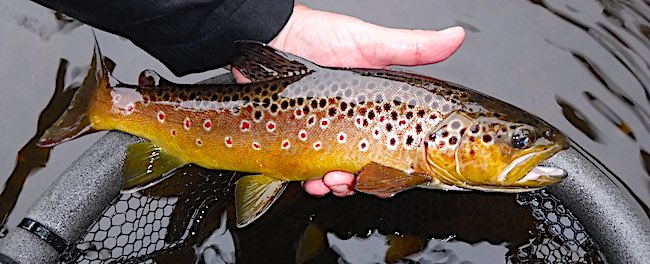
I hope you have the opportunity to witness a hatch this year, and that you’re able to try fishing one of these caddis fly patterns.
Acknowledgement
Finally, a kind thanks to Gareth Lewis for providing the photograph of the Grannom fly for this article.

Nice flys
Cheers
Beautifully explained and photographed. Thank you and keep it up!
Hi Charles,
Thanks for the comments.
Andrew